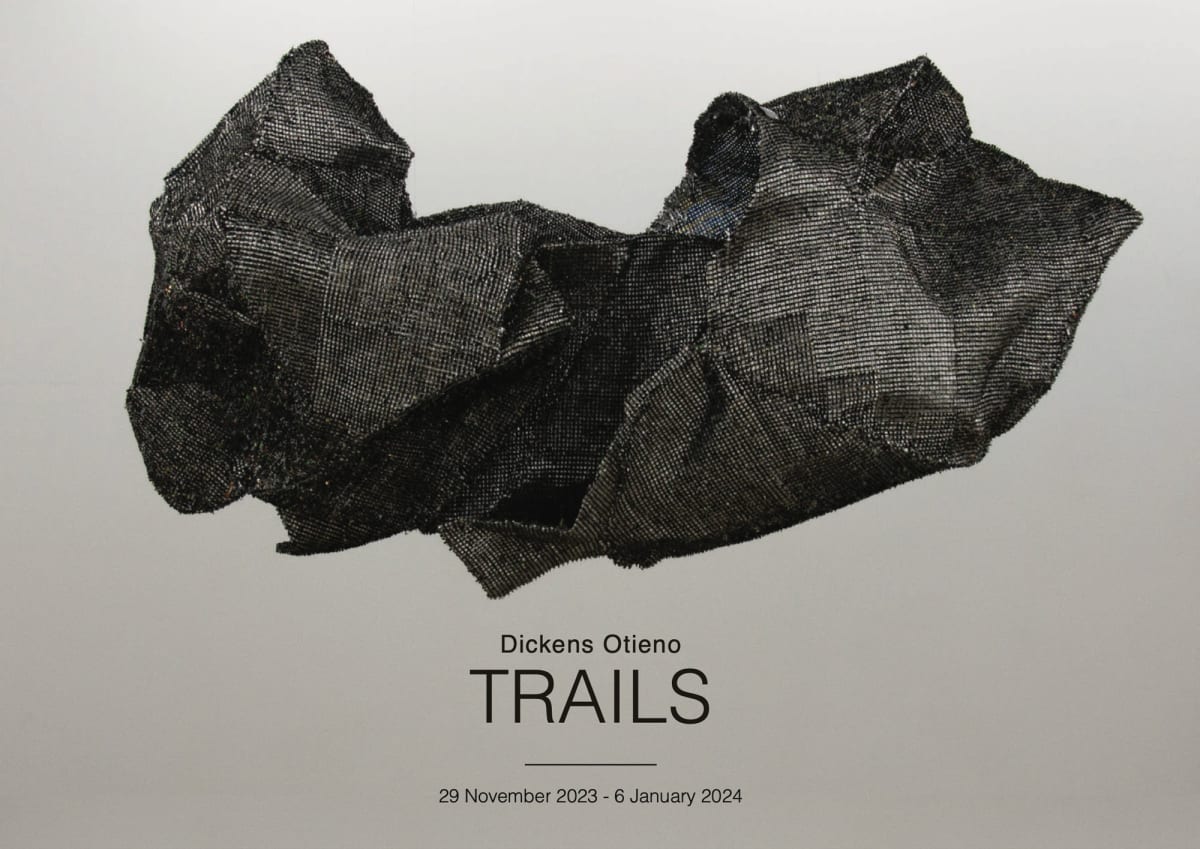Dickens Otieno: Trails: Circle Art Gallery
Since March of this year, Dickens Otieno has been in transit between Nairobi and Migori in Western Kenya, a recurring journey that is the genesis of the works in the current exhibition, Trails.
The seven-hour drive in either direction formed a meditative environment for Dickens to rewire his relationship with his childhood home in Migori, a process that has opened up new channels of inspiration, and explorations in psychogeography. Whether it is winding through fields of maize and sugarcane, alongside smaller kitchen gardens that serve everyday vegetable needs, or watching cattle grazing with younger calves tethered to small trees, observing and translating the specificity of this farming landscape has materialised in meticulous sculptural tapestries for his second solo exhibition at Circle.
In one of his largest works to date, Panya Routes, monumental at 3.11 x 5.93 m, Dickens observes paths made in wild grass by cane rats and other small field animals, while also alluding to road networks and the web of feeder roads that open into highways. It is here that the exhibition title emerges, Trails. With this as a departure point, Dickens creates different permutations of details in the landscape through a series of emergent patterns that speak to various ecosystems in both urban and rural contexts. During this time, not only making environmental observations but also taking notes on technique by revisiting the crafting methods associated with weaving baskets and making ropes, Dickens continues to play and experiment with the galvanised steel looms he forms to create new visual effects be it through raised surfaces, or leaving gaps in the weaving. He rewards the viewer for close-looking. In the diptych Darkening Clouds, Dickens not only expands his ideas for how the tapestries appear in space, in this case, installed to hang from above but also explores weaving techniques that trick the eye with an illusion of appearing darker or more silvery depending on the angle at which the viewer looks at the work. Dickens here thinks back to indigenous farming wisdom of observing clouds and based on their shape and colour, being able to predict whether it would rain, and maybe even extrapolate for how long, while in these modern times, there are several instruments deployed by the meteorological centres towards this. In Waves (Oscillations), Dickens weaves blue, silver and gold shredded aluminium cans to create an undulating surface that mimics and magnifies the reflection of light on water, highlighting the silvery crests and blueish troughs. Much like the nature of the interference between the light and water causes a uniform shimmer, the tightly woven and colour-blocked warps and wefts form a steady pattern that is balanced to the eye, prompting a calming effect much like standing before a large body of water, in this case summoning the feeling that Dickens gets while standing on the shore of Lake Victoria.
Similar to his interest in water which is a recurring theme in his tapestries, Dickens finds himself returning to his series of free-standing garment sculptures; and for this exhibition, features two shirt and short pairings, and one shirt and skirt pairing, as well as a woven tapestry titled Sketchbook page, Uniform Series. The first in this expansion of the Uniform series, the charming tapestry mimics a ruled page of an exercise book with sewing measurements outlined in loose font, approximating at a tailor’s handwritten notes for a custom fit. Growing up, Dickens watched his mother, a tailor with close regard for fabric and pattern, and while for him the medium has changed, working with recycled shredded aluminium cans on galvanised steel frames, the elements of fashion design continue to hold his attention to colour, construction, shape and texture.
Adopting the position of a learner and expanding his studio practice
Since his first solo exhibition at Circle in 2020, Mabati Tailor, Dickens speaks of his ongoing process of learning through doing, and the place of studying other artists’ practices as a muse to scale up his studio practice. As one of the four artists who represented the Kenyan Pavillion at the 59th Venice Biennale 2022, alongside Syowia Kyambi, Kaloki Nyamai and Wanja Kimani, Dickens was both incredibly honoured and inspired to expand his studio practice, now working with several assistants which he says has allowed him to ‘catch up with the ideas in my mind freeing up time for the thinking as well as the doing’.
Otieno has had solo exhibitions in Kenya and the USA: Mtaani, Steve Turner, Los Angeles, 2021, Mabati Tailor, Circle Art Gallery, 2020 and Trails, Circle Art Gallery, 2023. He has participated in numerous group exhibitions locally and internationally including: East African Encounters, Cromwell Place, London, 2021; See Here, Old Neals Auction House, Nottingham, 2018; Africa/Africa, Total Arts Courtyard Gallery, Al Quoz, Dubai, 2018; Young Guns, Circle Art Gallery, Nairobi, 2017; The Third Dimension, Circle Art Gallery, 2016; UNI-FORM MULTI-FORM, Roots Contemporary, Nairobi, 2016; Paint and Metal, National Museum of Nairobi, 2016. Otieno has exhibited at international art fairs including Art Dubai, Eye of the Collector, London, Circle Art Gallery, 2023 and Untitled Art Fair, Miami, Steve Turner Gallery, 2022. Residencies include the Tilleard Artist Residency in Lamu and a fellowship in Italy at the Civitella Ranieri Foundation. His work features in various collections including the A.R.M Holdings collection, the Africa First collection, ARAK collection, BASMOCA collection, Fahard Bakhitar collection, Fondation Gandur pour l'Art Geneva, Kamita Art Collection, Leridon Collection, Perez Museum collection, Qambani Collection, TAAT collection and the Waugh McDonald collection. In 2025 he was shortlisted for the Loewe Foundation Craft Prize.
Rising to the challenge of a solo exhibition in the new gallery space, five times the size of Circle’s first gallery, Dickens has woven together an immersive experience for viewers to enjoy featuring eight large tapestries and three free-standing garments demonstrating what is possible with new dreaming, drive and devotion.















